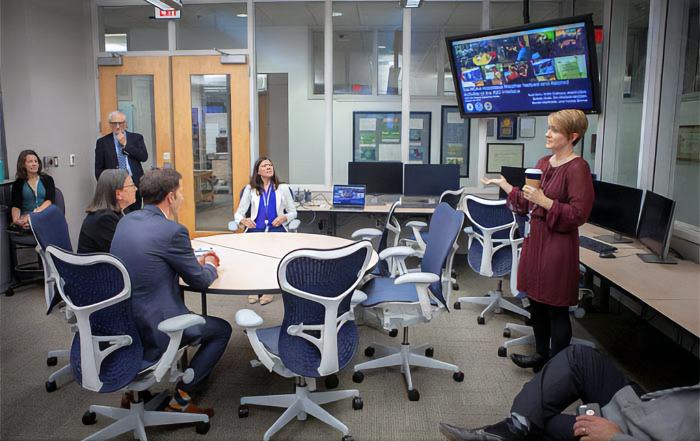In the rapidly evolving financial landscape of 2025, the global wealth management industry has become a cornerstone for individuals, families, and institutions seeking structured financial guidance. The demand for comprehensive wealth management services is being driven by rising global wealth, digital transformation, the integration of artificial intelligence, and the growing importance of sustainable investing. The industry’s leading firms are no longer simply investment managers — they are strategic partners offering digital innovation, estate planning, sustainability insights, and cross-border financial expertise. This article, written for tradeprofession.com, provides a detailed examination of the Top 10 Companies in Wealth Management, highlighting their services, innovations, and the factors that make them stand out in today’s financial ecosystem.
The Evolution of Wealth Management in 2025
The global wealth management sector has expanded significantly due to technological disruption and client expectations for transparency and personalization. High-net-worth individuals (HNWIs) and ultra-high-net-worth individuals (UHNWIs) increasingly seek firms that combine human expertise with advanced technology. According to market data from Deloitte and PwC, digital client engagement tools, ESG integration, and AI-driven portfolio analytics are now central to how top wealth management companies operate.
In this dynamic environment, the leading firms have diversified their services across multiple domains — from financial planning and asset management to tax optimization, philanthropy, and intergenerational wealth transfer. They emphasize responsible investment strategies aligned with sustainability goals, reflecting the global shift toward sustainable business practices and socially responsible portfolios.
1. UBS Group AG
UBS remains one of the most dominant names in global wealth management. Headquartered in Switzerland, UBS manages trillions in client assets and is recognized for its personalized service model and integration of cutting-edge technology. The company’s Global Wealth Management Division combines advisory services, financial planning, and digital solutions under one umbrella.
UBS’s My Way platform allows clients to tailor portfolios through a digital interface while leveraging real-time analytics. Additionally, the firm has taken a leadership position in ESG investing, offering sustainable portfolio products that align with the UN Sustainable Development Goals (SDGs). Its expertise in cross-border wealth management and private banking makes UBS particularly attractive to international clients.
Learn more about UBS’s latest sustainable initiatives on UBS.com.
2. Morgan Stanley Wealth Management
Morgan Stanley has built its reputation on blending institutional expertise with individualized wealth management. Following its acquisition of E*TRADE and Solium, Morgan Stanley has enhanced its ability to deliver digital and equity compensation solutions for executives and entrepreneurs.
The company’s Next Best Action technology integrates artificial intelligence to provide proactive insights for advisors and clients, ensuring portfolios remain aligned with client goals and market conditions. The firm’s sustainability and impact investing division continues to grow rapidly, appealing to a new generation of socially conscious investors.
Professionals interested in understanding financial innovation can explore innovation strategies shaping the wealth management industry.
3. J.P. Morgan Private Bank
J.P. Morgan Private Bank, part of JPMorgan Chase & Co., caters to ultra-wealthy clients worldwide with comprehensive financial and lifestyle advisory services. The firm’s wealth management approach integrates global investment insights, estate planning, philanthropy management, and access to private markets.
Its digital transformation strategy includes AI-powered research, personalized financial dashboards, and advanced cybersecurity protocols to protect client data. J.P. Morgan’s Sustainable Investing Team has developed frameworks that help clients align their portfolios with environmental and social outcomes, underlining its commitment to responsible wealth management.
For further insights into financial innovation, visit tradeprofession.com/technology.html.
4. Goldman Sachs Private Wealth Management
Goldman Sachs offers one of the most sophisticated private wealth management services globally. The firm serves institutional and private clients, emphasizing diversification, risk mitigation, and access to alternative investments. Its technology-driven advisory system combines quantitative analysis with qualitative financial goals.
The Marcus by Goldman Sachs digital banking platform has broadened access to wealth management tools for mass-affluent clients, demonstrating the firm’s focus on democratizing financial planning. Moreover, Goldman Sachs Asset Management (GSAM) continues to lead in ESG and impact investing, particularly through its thematic funds in clean energy, gender equality, and sustainable infrastructure.
Learn more about responsible investment options from Goldman Sachs Asset Management.
🏆 Top 10 Wealth Management Companies 2025
Explore the world's leading wealth management firms and emerging industry trends
UBS Group AG
Global leader managing trillions in assets with personalized service and cutting-edge technology integration. Known for sustainable investing aligned with UN SDGs.
Morgan Stanley Wealth Management
Combines institutional expertise with individualized service. Enhanced digital capabilities through E*TRADE acquisition.
J.P. Morgan Private Bank
Serves ultra-wealthy clients with comprehensive financial and lifestyle advisory. AI-powered research and advanced cybersecurity.
Goldman Sachs Private Wealth
Sophisticated wealth management with emphasis on alternative investments and technology-driven advisory systems.
Credit Suisse Wealth Management
Strong position in Asia and Europe. Merged with UBS in 2023 creating one of the largest consolidated platforms.
Charles Schwab
Transformed accessibility through digital platforms and robo-advisory. Known for transparency and client education.
Bank of America Private Bank
Comprehensive investment management with Merrill's research strength. Focus on sustainability and measurable impact.
RBC Wealth Management
Global leader in personalized advisory with strong presence across North America, Europe, and Asia.
Citi Private Bank
Focuses on global entrepreneurs and family offices with seamless cross-border wealth management capabilities.
Northern Trust Wealth Management
Over a century of experience with modern innovation. Leading blockchain integration and institutional-grade services.
🤖 AI-Driven Insights
Predictive analytics and machine learning enable personalized advice, risk management, and real-time portfolio optimization across all major platforms.
🌱 Sustainable Investing
ESG principles are now integral to every investment discussion. Global sustainable assets have surpassed $5 trillion and expected to double by 2028.
👥 Personalization
Behavioral analytics and AI tools enable customized solutions that reflect individual values, timelines, and risk appetites for each client.
₿ Digital Assets
Cryptocurrencies and tokenized assets are now legitimate diversification instruments with regulated investment vehicles and custody solutions.
🏛️ Family Offices
Family offices now control over $6 trillion in assets, managing intergenerational wealth, succession planning, and impact investments.
⚖️ RegTech Compliance
Automated compliance monitoring and AI-powered transaction detection ensure transparency and regulatory adherence across global operations.
💡 Looking Ahead
By 2030, AI will act as a co-pilot in decision-making, sustainability will become the universal standard, and $80 trillion in wealth will transfer between generations.
Leading digital transformation with hybrid advisory models
Forefront of sustainable investing and green finance
Rapidly growing wealth hubs in Singapore, Hong Kong, Tokyo
Sovereign wealth funds and Sharia-compliant portfolios
🌐 Global Wealth Distribution
Traditional centers like the US, Switzerland, and UK dominate AUM, but emerging markets in Asia, Middle East, and Africa are rapidly gaining importance due to rising affluence and digital adoption.
| Feature | Traditional Firms | Digital-First | Hybrid Model |
|---|---|---|---|
| Personal Advisor | ✓ High Touch | Limited | ✓ Balanced |
| AI/Technology | Growing | ✓ Core Focus | ✓ Integrated |
| Minimum Investment | High ($1M+) | Low ($500+) | Medium ($25K+) |
| ESG Integration | ✓ Standard | ✓ Standard | ✓ Standard |
| Alternative Assets | ✓ Extensive | Limited | ✓ Available |
| Global Reach | ✓ Extensive | Regional | ✓ Growing |
| Family Office Services | ✓ Full Suite | None | Selected |
| Crypto Integration | ✓ Regulated | ✓ Native | ✓ Available |
📊 Choosing the Right Model
The best wealth management approach depends on your assets, goals, and preferences. Traditional firms offer comprehensive services for complex needs, digital-first platforms provide accessibility and low costs, while hybrid models balance technology with human expertise.
5. Credit Suisse Wealth Management
Despite facing restructuring challenges in previous years, Credit Suisse continues to hold a strong position in global wealth management, particularly in Asia and Europe. Its merger with UBS in 2023 created one of the largest consolidated wealth management platforms in history, allowing clients to benefit from greater scale and resources.
The firm offers comprehensive services including private banking, investment consulting, philanthropy advisory, and succession planning. Credit Suisse’s focus on innovation remains evident through its Digital Private Banking app, providing real-time access to portfolio performance, investment insights, and market trends.
For business professionals exploring the intersection of finance and digital transformation, tradeprofession.com/banking.html offers valuable insights.
6. Charles Schwab
Charles Schwab has transformed wealth management accessibility by combining advanced digital platforms with human advisory support. Known for its Schwab Intelligent Portfolios®, the company leverages automation and AI to help clients achieve diversified portfolio management at a lower cost. Schwab’s commitment to transparency and client education is a defining factor in its success.
Its acquisition of TD Ameritrade further enhanced its client base and technology infrastructure. Schwab now serves millions of investors through hybrid advisory models, which combine robo-advisory and personal financial planning services. The company’s strong regulatory compliance and customer trust ratings underscore its credibility as a leading financial institution.
For a deeper look into the role of innovation in financial services, visit tradeprofession.com/business.html.
7. Bank of America Private Bank (Merrill)
Bank of America Private Bank, formerly known as U.S. Trust, continues to serve affluent clients through comprehensive investment management and estate planning solutions. The firm benefits from the research and analytical strength of Merrill, offering clients integrated solutions that include customized lending, philanthropy, and trust administration.
Its Merrill Guided Investing platform provides digital and hybrid advisory services, allowing clients to balance automation with human advice. Furthermore, the firm’s sustainability strategy prioritizes investments that create measurable social and environmental impact, aligning with the broader goals of sustainable capitalism.
Discover more about global financial trends on tradeprofession.com/global.html.
8. RBC Wealth Management
RBC Wealth Management, the wealth arm of Royal Bank of Canada, has become a global leader in personalized financial advisory and wealth preservation. With a strong presence in North America, Europe, and Asia, RBC provides comprehensive financial planning, portfolio management, and trust services. Its digital transformation initiatives have empowered both clients and advisors to make data-driven investment decisions through advanced analytics.
The company’s RBC Wealth Insights platform integrates predictive modeling and behavioral finance to improve financial outcomes. RBC is also known for supporting sustainable finance initiatives, investing heavily in climate-conscious portfolios and green bonds.
For those exploring investment strategies and financial education, tradeprofession.com/investment.html provides valuable context.
9. Citi Private Bank
Citi Private Bank is distinguished by its focus on global entrepreneurs, family offices, and institutional investors. The bank’s structure allows seamless cross-border wealth management for clients with complex international financial needs. It offers tailored investment portfolios, tax optimization, and succession planning through digital collaboration tools.
Citi’s Wealth at Work and Family Office Advisory divisions provide holistic financial solutions that include risk management, philanthropy, and sustainable investment integration. The company’s Citi Velocity platform enables institutional-grade data analysis and global market access for sophisticated investors.
Professionals seeking to understand the evolving global economy can refer to tradeprofession.com/economy.html.
10. Northern Trust Wealth Management
Northern Trust combines over a century of experience with modern technological innovation. It provides institutional-grade financial services to affluent individuals, family offices, and nonprofit organizations. The firm is known for its meticulous risk management framework and its Front Office Solutions, which provide real-time portfolio transparency across asset classes.
Northern Trust’s Wealth Passport digital platform enhances client experience with secure document management and global access to investment data. The firm is also at the forefront of blockchain integration for record-keeping and compliance, setting new industry standards in operational efficiency.
For insights into how technology is reshaping financial services, read more on tradeprofession.com/artificialintelligence.html.
Emerging Trends in Wealth Management
Digitalization and AI-Driven Insights
Artificial intelligence continues to redefine how advisors interact with clients and manage portfolios. Predictive analytics, generative AI, and machine learning models enable wealth managers to anticipate client needs, manage risks, and customize advice. Firms are deploying AI chatbots and RPA (Robotic Process Automation) to handle operational tasks, freeing human advisors to focus on strategic consulting.
Platforms like BlackRock’s Aladdin and Morningstar Direct demonstrate how data analytics and AI enhance decision-making and transparency. This trend reflects a broader shift toward tech-empowered advisory models that improve efficiency and client satisfaction.
Sustainable and Responsible Investing: The New Wealth Frontier
As wealth management evolves, sustainability has emerged as one of the defining trends shaping the industry. In 2025, environmental, social, and governance (ESG) principles are no longer optional — they are integral to every investment discussion. Wealth management firms are prioritizing sustainable portfolios that align financial growth with ethical responsibility. The rise of climate-conscious investors, especially millennials and Gen Z, has fueled this transformation. According to recent insights from Morningstar, global sustainable assets have surpassed $5 trillion, a figure expected to double by 2028.
Leading companies such as UBS, BlackRock, and Goldman Sachs have expanded their sustainability platforms, offering thematic investments in renewable energy, water security, and inclusive growth. These initiatives align closely with global sustainability goals and provide clients with the opportunity to generate returns while making a positive impact.
To explore how sustainability is redefining corporate leadership, readers can visit tradeprofession.com/sustainable.html for insights into ethical business practices and future-ready investment models.
The Role of Technology and Digital Innovation
Technology has become the backbone of modern wealth management, enabling efficiency, personalization, and scalability. The integration of artificial intelligence, blockchain, and cloud computing has transformed how advisors serve clients and manage assets. Firms such as J.P. Morgan, RBC, and Charles Schwab have adopted hybrid models that merge human insight with AI analytics to provide 24/7 advisory support.
Digital wealth platforms now allow clients to visualize entire portfolios, simulate financial outcomes, and receive real-time market updates. Blockchain, in particular, is revolutionizing transaction security and transparency, enabling faster settlements and verifiable ownership records. AI systems are being used to detect financial anomalies, assess risk exposure, and optimize investment strategies with a level of precision that was unimaginable just a decade ago.
For more about innovation in the financial sector, readers can explore tradeprofession.com/technology.html and tradeprofession.com/innovation.html.
Personalization: The Heart of Client Experience
The modern wealth management experience centers on personalization — the ability to tailor portfolios and services to meet individual life goals. Clients no longer seek generic investment advice; they expect customized solutions that reflect their values, timelines, and risk appetites. Firms are leveraging behavioral analytics to understand client motivations, enabling more precise financial planning.
Morgan Stanley’s “Next Best Action” tool exemplifies this evolution. By combining real-time data with behavioral insights, the firm delivers timely, contextually relevant recommendations to advisors. Similarly, UBS’s My Way and Goldman Sachs’s Marcus platform have made personalization a competitive differentiator, ensuring that clients receive strategies that evolve alongside their life circumstances.
Wealth managers increasingly position themselves as life partners — not just financial advisors. This shift toward relational value ensures that clients receive integrated advice across savings, retirement, tax planning, philanthropy, and legacy management. It also reinforces the growing convergence between financial planning and emotional intelligence, underscoring the human side of wealth.
To learn more about global business leadership and financial strategies, visit tradeprofession.com/executive.html.
Regional Perspectives: Global Wealth Distribution and Market Insights
The geography of wealth management continues to diversify. Traditional centers like the United States, Switzerland, and the United Kingdom still dominate global assets under management (AUM). However, emerging markets in Asia, the Middle East, and Africa are rapidly gaining importance due to rising affluence, digital adoption, and favorable regulatory reforms.
North America
In the United States and Canada, wealth management firms are embracing technology to improve scalability and compliance. Morgan Stanley, Charles Schwab, and RBC lead this transformation by introducing digital-first client onboarding, secure document exchange systems, and hybrid advisory models.
Europe
Europe remains at the forefront of sustainable investing. UBS, Credit Suisse, and Deutsche Bank Wealth Management have established ESG-integrated frameworks that align with the European Green Deal and the SFDR (Sustainable Finance Disclosure Regulation). Investors are increasingly directing capital toward green bonds and ethical funds, contributing to the continent’s sustainability transition.
Asia-Pacific
Markets like Singapore, Hong Kong, and Tokyo are becoming wealth management hubs for high-net-worth individuals across Asia. Firms such as HSBC Private Banking, Citi Private Bank, and UBS Asia-Pacific provide bespoke wealth solutions tailored to regional regulations and cultural nuances. The surge in family offices and cross-border investments has further amplified Asia’s role in global financial flows.
Middle East and Africa
The Gulf region has witnessed the rapid growth of sovereign wealth funds and private family offices, notably in Dubai and Abu Dhabi. Firms such as Credit Suisse and BNP Paribas Wealth Management have established regional offices to cater to high-value investors seeking Sharia-compliant and ESG-aligned portfolios.
Readers interested in cross-border business strategies can explore tradeprofession.com/global.html for global economic perspectives and market insights.
The Rising Role of Family Offices
Family offices have become essential in managing intergenerational wealth and succession planning. These specialized entities oversee comprehensive wealth strategies for ultra-high-net-worth families, including philanthropy, tax management, real estate, and impact investments. According to EY Global Family Office Study, family offices worldwide now control over $6 trillion in assets, and their influence continues to grow.
The world’s top wealth managers collaborate closely with family offices to provide access to exclusive investments such as private equity, venture capital, and hedge funds. J.P. Morgan, Goldman Sachs, and Northern Trust have launched dedicated family office divisions that offer tailored governance frameworks and education programs for younger generations.
This evolving model of stewardship reflects a long-term view of wealth — not merely as an accumulation of assets, but as a vehicle for legacy, sustainability, and global influence.
Digital Assets and Cryptocurrency Integration
The integration of digital assets into traditional wealth portfolios is another defining trend of 2025. Cryptocurrencies, once considered speculative, are now seen as legitimate diversification instruments. Major firms like Morgan Stanley, Fidelity, and UBS have introduced regulated crypto investment vehicles for accredited investors. Additionally, BlackRock’s iShares Bitcoin ETF has accelerated mainstream adoption of blockchain-based assets.
Wealth management platforms now provide crypto custody solutions, tax reporting tools, and blockchain analytics to ensure transparency and compliance. The tokenization of real-world assets — such as real estate, art, and private equity — is transforming how investors access illiquid markets. Wealth managers increasingly act as interpreters between the traditional and digital economies, guiding clients through regulatory frameworks and volatility management.
Professionals exploring crypto finance can gain deeper understanding through tradeprofession.com/crypto.html.
Regulation and Compliance in 2025
With growing digitalization and global interconnectivity, regulatory frameworks have become more complex. Governments and financial regulators emphasize data protection, anti-money laundering (AML) measures, and environmental disclosure standards. The Financial Action Task Force (FATF), SEC, and European Securities and Markets Authority (ESMA) continue to tighten compliance obligations for wealth managers.
Leading firms have invested in RegTech — regulatory technology tools that automate compliance monitoring and reporting. For instance, BNY Mellon and Northern Trust utilize AI to detect irregular transactions and maintain real-time audit trails. The result is a financial ecosystem that is both more transparent and resilient.
To understand how compliance trends impact executive strategy, readers can refer to tradeprofession.com/executive.html.
Human Expertise: The Irreplaceable Element
Despite rapid digitalization, the human element remains at the core of effective wealth management. Trust, empathy, and interpersonal understanding are essential in financial advisory relationships. Clients entrust not only their capital but their aspirations, family goals, and legacy plans to wealth managers.
Top firms invest heavily in advisor training and behavioral finance education, ensuring their professionals can interpret emotional and psychological dimensions of client decisions. Human insight complements algorithmic precision, ensuring strategies remain aligned with clients’ evolving life stages and priorities.
Educational institutions and organizations like CFA Institute continue to emphasize ethical standards, transparency, and professional development as vital components of modern financial advisory services. For readers seeking more on leadership education in finance, tradeprofession.com/education.html provides valuable perspectives.
The Future of Wealth Management: Predictions for the Next Decade
The next decade will bring fundamental shifts in how wealth is created, managed, and preserved. Several megatrends are expected to shape the sector’s future:
AI-Enhanced Advisory Models
By 2030, AI will not only assist advisors but act as a co-pilot in decision-making. Predictive analytics will forecast life events and propose investment strategies in real time. Wealth managers that successfully balance automation with personal engagement will dominate the market.
Sustainable Finance as Default
Sustainability will evolve from a niche investment theme to a universal standard. Every major portfolio will integrate ESG criteria, and clients will increasingly measure success by both financial and social returns.
Intergenerational Wealth Transfer
An estimated $80 trillion in wealth will be transferred between generations over the next two decades. Firms that provide intergenerational education, mentorship, and inclusive advisory frameworks will attract enduring client loyalty.
Global Digital Wealth Ecosystems
The rise of open banking and cross-border fintech collaboration will foster integrated digital ecosystems where clients can manage assets, taxes, and philanthropic projects globally through unified dashboards.
To understand how technology and global investment strategies are converging, visit tradeprofession.com/global.html and tradeprofession.com/investment.html.
Conclusion
The top ten wealth management firms of 2025 represent more than financial institutions — they are strategic partners, innovators, and custodians of trust. In a world defined by economic volatility, digital transformation, and ethical responsibility, these organizations stand at the intersection of human wisdom and technological advancement. They shape how individuals and institutions secure their financial futures, promote sustainability, and define legacy.
From UBS’s personalized platforms to Morgan Stanley’s AI-powered advisory models, from Goldman Sachs’s digital democratization to Northern Trust’s blockchain innovation, the global wealth management landscape continues to evolve toward inclusivity, transparency, and impact.
For business leaders, investors, and professionals navigating this evolving financial world, tradeprofession.com remains a trusted source for insights on banking, technology, investment, sustainability, and global finance — guiding the next generation of wealth creation with expertise, experience, and trust.










